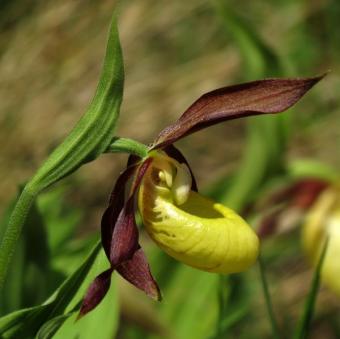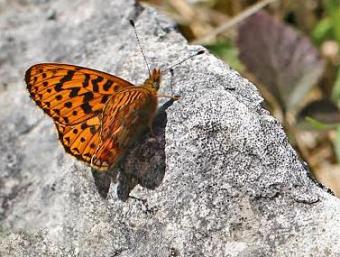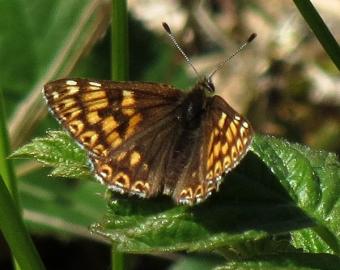 Limestone
LimestoneThe mini-bus was full for our trip to see the site’s famous Lady Slipper Orchids. Despite the weather forecasts to the contrary, we enjoyed warm sunshine throughout the day. We were therefore lucky enough to also see all the special spring butterflies and day-flying moths that this special site is renowned for.
We began by following the way-marked trail that led us to the orchids. Lady's Slipper Orchid This is the only public site of the 20 or so other sites where this orchid was re-introduced by the Kew Gardens Special Projects team. En route we saw Herb Paris, Speckled Yellow Moths, Brimstone butterflies and the wonderfully iridescent green Rosechafer beetle. Probably due to the recent cold, dry weather many of the plants were not yet in full flower. Fortunately there were more than enough in fresh bloom to excite the group and numerous excellent pictures were obtained. The site warden Rob Petley-Jones was on hand and he informed us that the other notable plant ‘Angular Solomon’s Seal’ was not yet in flower.
Lady's Slipper Orchid This is the only public site of the 20 or so other sites where this orchid was re-introduced by the Kew Gardens Special Projects team. En route we saw Herb Paris, Speckled Yellow Moths, Brimstone butterflies and the wonderfully iridescent green Rosechafer beetle. Probably due to the recent cold, dry weather many of the plants were not yet in full flower. Fortunately there were more than enough in fresh bloom to excite the group and numerous excellent pictures were obtained. The site warden Rob Petley-Jones was on hand and he informed us that the other notable plant ‘Angular Solomon’s Seal’ was not yet in flower.
Lunch was taken in the vicinity of the orchids. During this time we were treated to sightings of Green Hairstreak, Brimstones (male and female), Dingy Skippers and many of the attractive micro moths Pyrausta purpularis,cingulata and ostrinalis. Purpularis and cingulata have recently been given common names ‘Purple pyrausta’ and ‘Girdled pyrausta’. Ostrinalis is scarcer than the other two and has very similar upperwings to purpularis. I was, however, able to photograph the underside of one which looked a likely candidate, and was thus pleased to later confirm that it was in fact ostrinalis Pearl Bordered Fritillary .
Pearl Bordered Fritillary .
After this we travelled slowly along a nearby trail to search for the two nationally rare butterflies we had not yet seen. The vanguard soon found the Duke of Burgundy and several members got decent photos, albeit none from close range. Mind you; distance seems to be no great barrier to these modern cameras! The other one was a far trickier prospect however. When it did eventually put in an appearance it frustratingly flew quickly around and low to the ground, making it hard to keep track of.Typically, Pearl Bordered Fritillaries rarely fly above knee height and when they do settle it is often very briefly. Later in the day is probably the best time for photographs as that is when they are more likely to be found nectaring on Bugle. Only Martin was lucky or persistent enough to obtain a photo and a fine one it was too. Earlier on he had mislaid his spectacles whilst looking at a patch of Scarlet Pimpernel but Robert, our driver for the day, came to the rescue and soon found them.
 Duke Of Burgundy
Duke Of Burgundy
Next we headed on a southerly path which took us close to the main area of limestone pavement. Whilst the botanists were searching the grikes we were lucky to catch sight of another nationally rare moth the White-spotted Sable (Anania funebris): too elusive, however, to be photographed on this occasion. We then traversed the large meadow at the southern end of the site where I had hoped to spot the Small Yellow Underwing, a small macro moth I had seen there the year before, but no joy this time; possibly too breezy?On the main path back to the small car park we passed large clumps of Lily of the Valley a few of which were just coming into flower. Joan and Alice recorded over 90 plants, including Common Gromwell, Field Madder, Limestone Bedstraw and Mountain Mellick. It had been a memorable day out.
We left the site in good time and were back in Shipley before six. Toilet stops were taken at Kirby Lonsdale going and Gargrave on the return leg.
John Gavaghan
